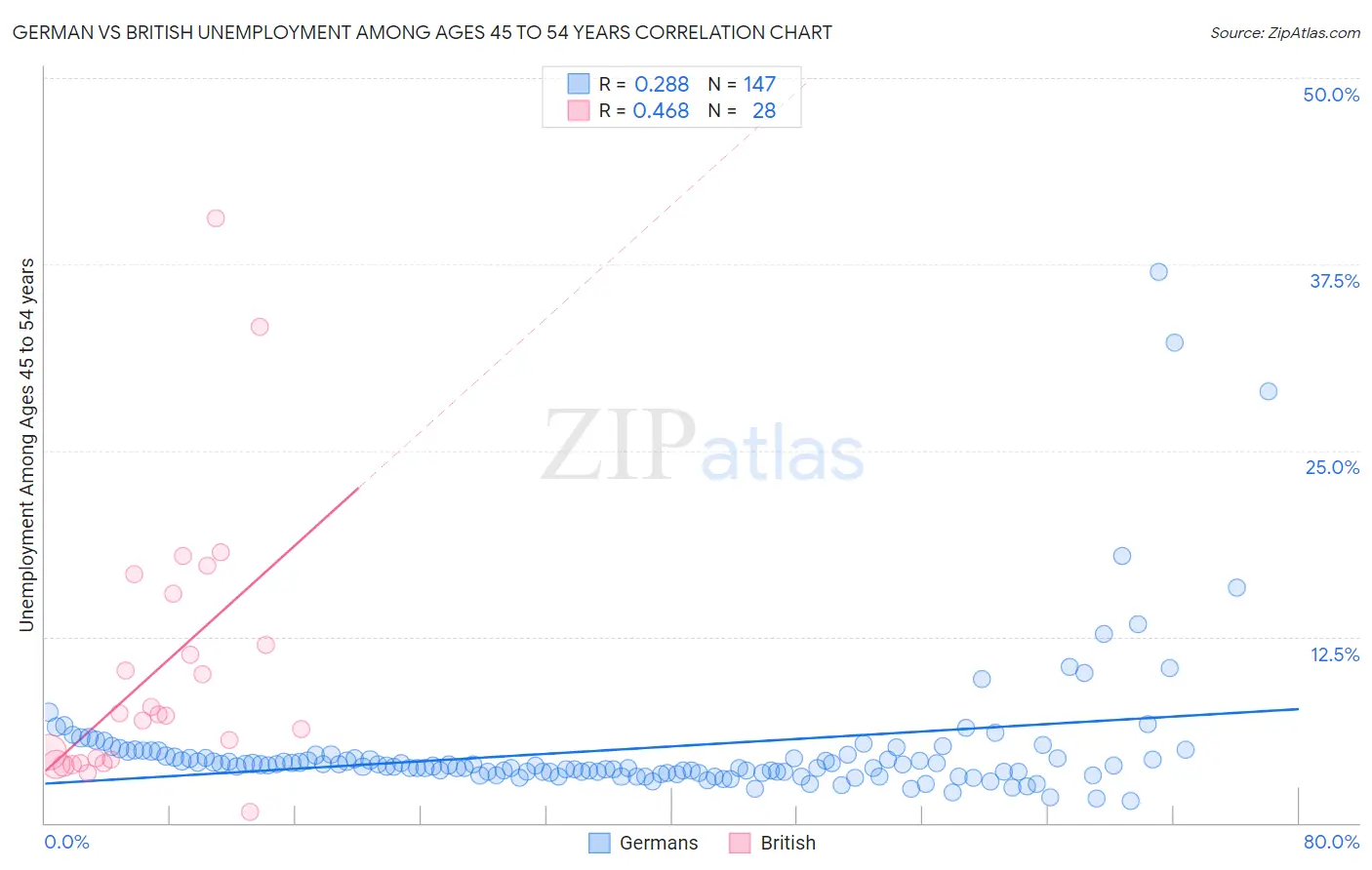German vs British Unemployment Among Ages 45 to 54 years
COMPARE
German
British
Unemployment Among Ages 45 to 54 years
Unemployment Among Ages 45 to 54 years Comparison
Germans
British
4.1%
UNEMPLOYMENT AMONG AGES 45 TO 54 YEARS
100.0/ 100
METRIC RATING
18th/ 347
METRIC RANK
4.1%
UNEMPLOYMENT AMONG AGES 45 TO 54 YEARS
99.9/ 100
METRIC RATING
30th/ 347
METRIC RANK
German vs British Unemployment Among Ages 45 to 54 years Correlation Chart
The statistical analysis conducted on geographies consisting of 533,496,511 people shows a weak positive correlation between the proportion of Germans and unemployment rate among population between the ages 45 and 54 in the United States with a correlation coefficient (R) of 0.288 and weighted average of 4.1%. Similarly, the statistical analysis conducted on geographies consisting of 500,941,484 people shows a moderate positive correlation between the proportion of British and unemployment rate among population between the ages 45 and 54 in the United States with a correlation coefficient (R) of 0.468 and weighted average of 4.1%, a difference of 2.4%.

Unemployment Among Ages 45 to 54 years Correlation Summary
| Measurement | German | British |
| Minimum | 1.4% | 0.72% |
| Maximum | 37.0% | 40.6% |
| Range | 35.6% | 39.9% |
| Mean | 4.9% | 10.3% |
| Median | 3.9% | 7.2% |
| Interquartile 25% (IQ1) | 3.4% | 4.2% |
| Interquartile 75% (IQ3) | 4.6% | 13.7% |
| Interquartile Range (IQR) | 1.2% | 9.5% |
| Standard Deviation (Sample) | 4.7% | 9.1% |
| Standard Deviation (Population) | 4.6% | 8.9% |
Demographics Similar to Germans and British by Unemployment Among Ages 45 to 54 years
In terms of unemployment among ages 45 to 54 years, the demographic groups most similar to Germans are Tongan (4.1%, a difference of 0.020%), Swiss (4.1%, a difference of 0.29%), English (4.1%, a difference of 0.45%), Thai (4.0%, a difference of 0.56%), and Immigrants from Bolivia (4.0%, a difference of 0.76%). Similarly, the demographic groups most similar to British are Belgian (4.1%, a difference of 0.010%), Bhutanese (4.2%, a difference of 0.020%), Slovene (4.2%, a difference of 0.13%), Welsh (4.1%, a difference of 0.14%), and Immigrants from South Central Asia (4.2%, a difference of 0.16%).
| Demographics | Rating | Rank | Unemployment Among Ages 45 to 54 years |
| Immigrants | Bosnia and Herzegovina | 100.0 /100 | #14 | Exceptional 4.0% |
| Immigrants | Bolivia | 100.0 /100 | #15 | Exceptional 4.0% |
| Thais | 100.0 /100 | #16 | Exceptional 4.0% |
| Tongans | 100.0 /100 | #17 | Exceptional 4.1% |
| Germans | 100.0 /100 | #18 | Exceptional 4.1% |
| Swiss | 100.0 /100 | #19 | Exceptional 4.1% |
| English | 100.0 /100 | #20 | Exceptional 4.1% |
| Europeans | 100.0 /100 | #21 | Exceptional 4.1% |
| Yugoslavians | 100.0 /100 | #22 | Exceptional 4.1% |
| Bulgarians | 100.0 /100 | #23 | Exceptional 4.1% |
| Carpatho Rusyns | 100.0 /100 | #24 | Exceptional 4.1% |
| Bolivians | 99.9 /100 | #25 | Exceptional 4.1% |
| Scottish | 99.9 /100 | #26 | Exceptional 4.1% |
| Immigrants | Moldova | 99.9 /100 | #27 | Exceptional 4.1% |
| Welsh | 99.9 /100 | #28 | Exceptional 4.1% |
| Belgians | 99.9 /100 | #29 | Exceptional 4.1% |
| British | 99.9 /100 | #30 | Exceptional 4.1% |
| Bhutanese | 99.9 /100 | #31 | Exceptional 4.2% |
| Slovenes | 99.9 /100 | #32 | Exceptional 4.2% |
| Immigrants | South Central Asia | 99.9 /100 | #33 | Exceptional 4.2% |
| Dutch | 99.9 /100 | #34 | Exceptional 4.2% |